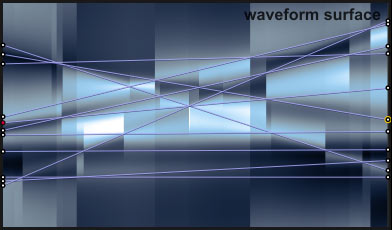Layers |

Don't cross pathsSo what's the point of layers? Well, you may have noticed that vertex paths aren't supposed to cross eachother. There's a good reason for this, and it's about not distorting the sound unintentionally. If in the menu bar Edit->Collision Detection is turned off, and you move vertices around, it's hard to avoid their paths crossing eachother and causing "glitches" in the sound. You can definitely make some cool noises that way, but in general use, it's not what you'd want. However, sometimes you need patterns to cross, say if there are multiple resonance peaks (like in the Buddha preset). Also sometimes in the time domain you might want to simulate detuning and paths will overlap, so to do this in Cycle we need multiple layers. Vertex paths on different layers don't interact with eachother, so there's no glitching problem. |
Stereo ImageAnother use for layers is to pan them to opposite sides and make a truly stereo tone. You can pan layers in all domains. To make stereo noise, pan two waveshape layers each with a noise deformer to either side. In the harmonic phase domain, a similar pair of noise layers will make a nice stereo breathiness. |
Scratch Channel MappingAnother feature is that each layer can be routed to its own scratch envelope, or they can share one, depending. In effect, different layers can loop at different speeds and transform independently. |
